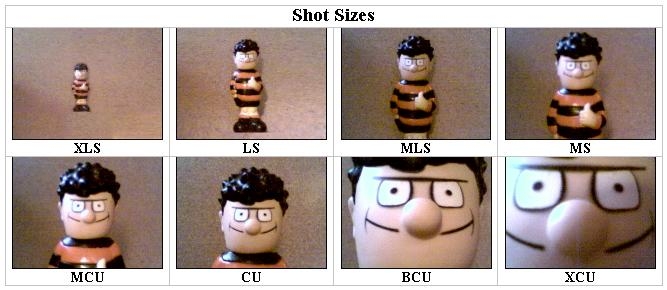
Introduction
-Intro
-semiotics
-denotation & connotation
-light & the mechanics of vision
-the basic visual elements
-montage & Mise-en-Scene
MONTAGE & MIS-EN-SCENE
Two concepts which relate to cinema and film, Montage and Mise-en-scene, are used by film producers to manipulate and audience. Montage ("to build") and Mise-en-scene ("to put into the scene") are two concepts which help to understand and interpret the processes of meaning-creation in film.
Montage is the editing together of disparate shots in order to create meaning. It characterized by a particular film editing method: shots are constructed rather than just 'edited' together. It is a process in which a number of shorter shots are woven together in order to communicate a great deal of information in a short period of time. Montage involves a "dialectical" process that creates a new third meaning from combining the meanings of the original two adjacent shots and involves really only two fundamental methods: the cut and the overlap.
We see this used very often today in commercials, music videos, and film. Applications such as After Effects have made it very easy to cut out and re-compose shots with montage effects.

A major purpose of montage is to create a narrative. A narrative is a chain of events,occuring in a given point in time, at a given point of space, where parts of it effect other parts. Major montage techniques used to produce narratives are linear, flashbacks, and cross or parallel editing which is used to track more than one story or character.
Reaction shot
Another useful editing technique involves showing a reaction shot, usually
a close-up or medium shot of a person. It is a reaction to a previous scene and
helps to heighten intensity or provide important clues to that person's personality.
Mise-en-scene is the relationship between the camera and what is being framed in its sights. This relationship includes spacing, angle and movement. Mise-en-scene is the organization of the shot which is an unbroken strip or film.
Historically, mise-en-scene meant directing plays, and later became used in film to express how the frame is organized.
Mise-en-scene items include lighting, actors, costumes, props, special effects, sound effects and the action of the camera (pan, zoom, tilt, dolly, etc.) It encourages the audience to view the audience in a specific way.
Camera shots
from: http://www.aber.ac.uk/media/Documents/short/gramtv.html
 Long
shot (LS). Shot which shows all or most of a fairly large subject (for example,
a person) and usually much of the surroundings. Extreme Long Shot (ELS) -
see establishing shot: In this type of shot the camera is at its furthest
distance from the subject, emphasising the background. Medium Long Shot (MLS):
In the case of a standing actor, the lower frame line cuts off his feet and
ankles. Some documentaries with social themes favour keeping people in the
longer shots, keeping social circumstances rather than the individual as
the focus of attention.
Long
shot (LS). Shot which shows all or most of a fairly large subject (for example,
a person) and usually much of the surroundings. Extreme Long Shot (ELS) -
see establishing shot: In this type of shot the camera is at its furthest
distance from the subject, emphasising the background. Medium Long Shot (MLS):
In the case of a standing actor, the lower frame line cuts off his feet and
ankles. Some documentaries with social themes favour keeping people in the
longer shots, keeping social circumstances rather than the individual as
the focus of attention.
Establishing shot. Opening shot or sequence, frequently an exterior 'General View' as an Extreme Long Shot (ELS). Used to set the scene.
Medium shots. Medium Shot or Mid-Shot (MS). In such a shot the subject or actor and its setting occupy roughly equal areas in the frame. In the case of the standing actor, the lower frame passes through the waist. There is space for hand gestures to be seen. Medium Close Shot (MCS): The setting can still be seen. The lower frame line passes through the chest of the actor. Medium shots are frequently used for the tight presentation of two actors (the two shot), or with dexterity three (the three shot).
Close-up (CU). A picture which shows a fairly small part of the scene, such as a character's face, in great detail so that it fills the screen. It abstracts the subject from a context. MCU (Medium Close-Up): head and shoulders. BCU (Big Close-Up): forehead to chin. Close-ups focus attention on a person's feelings or reactions, and are sometimes used in interviews to show people in a state of emotional excitement, grief or joy. In interviews, the use of BCUs may emphasise the interviewee's tension and suggest lying or guilt. BCUs are rarely used for important public figures; MCUs are preferred, the camera providing a sense of distance. Note that in western cultures the space within about 24 inches (60 cm) is generally felt to be private space, and BCUs may be invasive.
